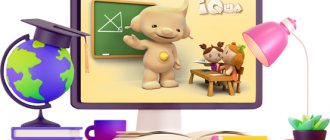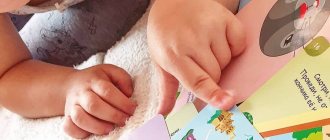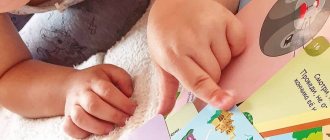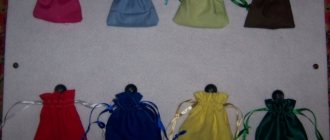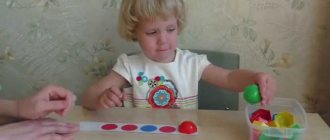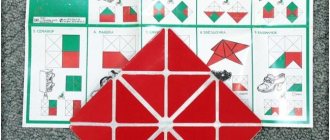Games that teach reading, sounds, letters
- Folding boxes . This game is based on the syllabic principle of Russian writing. It is a book, each spread of which is dedicated to all possible syllables with a certain consonant letter. On the same page there are pictures of animals and songs in which stressed syllables are highlighted. Folds are an improved syllabic alphabet. For the little ones there is a CD with songs included.
- Teremki Voskobovich. These are cubes based on the syllabic principle of Russian writing. The tower cubes are made of wood. There are 12 of them in total (2 of each color: white, gray, brown, purple, yellow, blue). Consonants are written on their edges. The tower cubes have windows. In these cubes you need to put cardboard chest cubes with vowels. Blue cubes for the letters A, O, U, E, Y, indicating the hardness of the consonants, green - for the letters Y, E, Yu, E, indicating the softness of the previous consonants. The same colors for hard and soft consonants are also preserved in folds.
Kids can play with the blocks as houses with windows. In each tower you can put pictures of animals (or small toys) on the letter drawn on the cube. To learn to read syllables, you need to put a chest cube in the tower cube, pronounce or sing the syllable.
- Funny letters . These are 10 cards representing vowels. They all depict Harlequin in different poses. They are called wittily: Harlequin, Urlekin, Orlekin, etc. They help develop imagination and remember the image of a letter.
- Reader on marbles . This is a square that you need to bend along the lines while reading the words. You can read up to 130 words.
- Lacing games for teaching reading: “Apple Tree”, “Snowman”, “Chamomile”. These are lacing of different shapes that connect letters into words. A child who does not know letters can play with them, just like lacing.
- The letter constructor introduces the “look” of each letter. There are rubber bands attached to the plywood base. Under these rubber bands, children insert the parts from which they make letters. There are 15 parts in total, different shapes. The creation of letters is accompanied by a fairy tale about adventures in the Violet Forest. It is the fairy tale that establishes the connection between letter and sound.
Games that teach numbers, counting, multiplication and other mathematical operations
- The ship "Plop-Plop". This is a three-dimensional plywood boat with wooden masts, numbered from 1 to 5, on which you need to put flags of the same color on each one. The game is accompanied by a fairy tale about a captain and a sailor, Goose and the Frog.
- The Splash-Splash boat . This is a flat boat on a carpet playing field with a deck glued on it. Each mast corresponds to a number from 1 to 7. You need to attach flag sails to it with Velcro of different colors.
- Boat "Bul-bul" . It is also flat, but it has ten masts. Accordingly, you can learn counting up to 100, four mathematical operations. The boat comes with tasks of varying difficulty.
- Math baskets . This game comes in different difficulty levels. You can put up to 10 mushrooms in each basket. A child collects mushrooms along with number animals. He must estimate how many mushrooms need to be added up to a dozen, and compares who has more mushrooms. The game gives an idea of the composition of numbers and teaches mathematical operations.
- Set of cards " Funny numbers ". Each number has the image of some animal. Cards develop imagination and help remember the image of a number.
- Transparent number . This game consists of stripes on a transparent film. The child must create numbers from them. Forms spatial thinking and combinatorics. Somewhat similar to the “Letter Constructor”, but made from different materials.
- Miracle flower . The game consists of plywood flowers, divided into parts. The child puts together a whole from parts, as well as figures according to the instructions.
- The “ Counting ” lace-up activity teaches addition and subtraction to up to 20 children aged 4 years and older. Can be used simply as lacing.
- Planet of multiplication . This is a game for a group of preschoolers or primary schoolchildren. During the game you can learn multiplication. You need to get to the spaceship through your shaft, alternating moves. Multiplication will be needed when counting votes.
Methodology
Each of Voskobovich's games has clearly defined pedagogical tasks and goals. But during the lesson, not only the child himself, but also the teacher disconnects from it. The kid helps decorate the boat with flags, arranges numbers from the album into the train cars, builds a magical web of strings, while gaining the most useful skills and knowledge for his age, from the development of fine motor skills, if we are talking about a 2-3 year old child, to solving equations. In most cases, the characters and environment are presented in the form of a construction set or mosaic. It will depend on the child himself how they will look in the process - this develops creative thinking, visual memory and a sense of taste.
General objectives of the development program:
- developing interest in the world around us, attention, memory, reducing attention deficit ratio, establishing trusting relationships with adults and playmates;
- developing research interest, creative thinking, and the ability to find non-standard solutions to situations;
- training of creative thinking, logical flexibility;
- psycho-emotional development, increased stress resistance, perseverance;
- practice of developing speaking, reading, and counting skills.
The plots and environments proposed by Voskobovich are only a support for conducting such classes. This is a multifunctional environment with secrets that the teacher himself can unexpectedly discover if he is sincerely interested in the process.
Voskobovich himself saw educational games only as part of the play process - the main activity of a child under the age of 7 years. His idea is to create a fairy-tale space in which the child will have to solve problems, but not imposed by the teacher, but arising as part of that fairy tale. This is exactly the kind of environment “The Violet Forest” should create as a fairy tale, for which the author created his unique characters:
- the wise raven Metro and the brave little Geo;
- invisible All and funny Magnolik;
- Digital Circus and Philemon Cotterfield;
- spider Yuk and the disappearing ice floes;
- Miracle Flower and Bee Zhuzha.
All objects that are offered to the child during the educational process are tied to and are part of this fairy tale. Thus, the tasks posed on Geokont, invented much earlier, began to be solved much more actively when, by the will of the author, it turned into the territory of the spider Yuka. It is more interesting for a child to place not abstract strings in accordance with the diagrams, but a magic web in a flower meadow. The creation process goes smoothly with pleasure from the task being solved - helping a specific character.
A universal sensorimotor environment allows activities to grow with the child. Using the same instrument, sometimes with replacement of its parts, the child learns first to identify colors, then to read and count, and then to solve complex logical algorithms.
The teacher in this story becomes a partner. The development of the plot also depends on it - only the basic elements are included with the tasks, which can be supplemented with available materials, developing both yourself and the child’s creative streak. The only condition for the implementation of the author's program remains a purple background, which stimulates creative thinking and creativity. It also allows you to abandon stereotypes in the display of elements from the first step.
How to play Voskobovich games
You need to carefully study the rules of the game and its fairy tale basis (after all, you will have to read the fairy tale or tell it to your parents). It is best to follow the methodological recommendations, complete the task one at a time, gradually complicating the game. There are parents who don't like to read instructions. They can play with the child as they please, and this will also be interesting and useful, but it is unlikely that the full potential of the game will be used.
If you are going to play Voskobovich’s games, it is better to purchase at least three games: educational, teaching reading and mathematics.
Voskobovich's games do not develop speech if the child plays them independently. Therefore, it is better to take part in his games and ask about the order and purpose of his actions, ask him to retell the plot of the fairy tale.
Games can be classified as board games (or “wall games”), so they do not contribute to the physical development of the child, but only to the intellectual and psychological. Parents themselves must take care of physical exercise. Remember that even a six-year-old child cannot concentrate on anything for more than 15 minutes.
Author
Vyacheslav Vladimirovich Voskobovich, an engineer and physicist from St. Petersburg, was puzzled by the search for educational toys for his own children in the early 90s.
The study of currently existing proposals did not yield anything - the range of domestic teaching material was extremely scarce, and international experience was practically not used.
Acquaintance with the experience of Zaitsev and Nikitins suggested the idea of creating a radically new system of classes, which would be not only useful, but also interesting for children, captivating and developing without forcing them to study. The main idea was to create tools for the comprehensive development of intelligence, logic, talent and personality in a playful way.
Voskobovich’s first games were “Geokont”, “Transparent Square”, “Folds”, “Two-Color Square”. appeared at the very beginning of the 90s. By 1997, the first training manual, “Little Geo, Raven Meter and I, Uncle Slava,” was written, which proposed combining classes with puzzles with a fairy tale twist that immerses the child in the story, giving an additional incentive to action and solving the problem.
In 1999, the author’s program “Fairy Tale Labyrinths of Games” was officially adopted and approved by the Education Committee of St. Petersburg. From now on, Voskobovich presents educational games in preschool educational institutions as an addition to activities that develop intellectual and creative thinking. By the beginning of the century, up to 90% of the city’s kindergartens used the method to one degree or another when organizing work with children.
Currently, the author of the system is the director of Voskobovich's Educational Games. The company and its tutoring center actively cooperate with the Union of Teachers of Russia and conduct training seminars free of charge, including in an online format in accordance with current reality.
Voskobovich's games for preschoolers and their descriptions are offered in sets designed for a certain age and are licensed. Buying an analogue is not encouraged, since the author himself believes that everything is taken into account in the original system. Exact adherence to the author's program, which teachers easily master, gives maximum results, despite the fact that within the framework of the game itself there is always a degree of unpredictable development. The child and the adult become co-creators.
Disadvantages of Voskobovich's games
And there are no shortcomings. There are always children for whom a certain technique is not suitable. Voskobovich's games are suitable for everyone. And this can be explained: in preschool age, play is the main activity of a person; in play he lives, grows, develops and learns. Therefore, the game is suitable for everyone.
Children studying according to the Voskobovich method usually show a good level of development of memory, thinking, attention, as well as the ability to concentrate on the task at hand and bring it to the end. These children have a well-developed desire to learn and explore something new, which is important for the learning process at school.
Advantages
Teachers using the methodology note two main advantages - an integrated approach to the development and education of children and the completeness of the proposed tools.
The game includes a developing subject environment for action, elements for manipulation, and complete instructions for an employee of an educational institution. This also helps parents who do not have a pedagogical education - they can get acquainted with the system within a couple of hours (study the manual or get acquainted with the recommendations for a specific game on the manufacturer’s website for free) and conduct a lesson with the child on their own.
The author himself insists that the merits of his system are the quality of children’s development:
- the emergence of the skill to receive and analyze information;
- development of creative thinking, reading and counting skills;
- the emergence of a model of behavior in society, empathy and compassion;
- formation of perseverance, desire to achieve goals, healthy persistence.
Moreover, everything happens in a playful, imperceptible form. The child simply plays, perceiving the didactic material as just another form of entertainment.
The quality of factory toys should also be noted. Materials approved by sanitary control authorities are used for production. When used in educational institutions, visual aids do not lose their appearance for a long time, even with regular sanitization. The content-rich environment is also transformable and completely safe.

